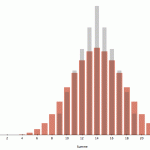Nope, we understand the stacking limits for zones/reinforcement areas, the number of units for each respective beachhead, etc. I understand that on turn 1 the max US reinforcements are 4 infantry at Utah. The only rule about the whole game I’m not totally certain of is if airborne units make targeted attacks during Phase 1 of Turn 1. It doesn’t really say either way…so we have been playing that it isn’t targeted although it was a matter of a 30 minute debate lol. So yeah…we understand the rules properly. =D
We used to all play A&A years ago, then college, careers, family, etc. happened. But while I was Christmas shopping for my grandson, I saw the D-Day game as well as GC and BoB and picked them up for myself. So no rules inheritance either. Weve all been working on the German strategies today, and I like my approach the best. I go after the US troops coming in from Utah and send most of the loose units not near Caen towards Utah beach and the zone south of it which is adjacent to Omaha. That zone allows me to keep either beachhead supplied from the handful of units I have to the south (in addition to 3 Inf and a Tank reinforcement I bring up). The remaining units coming in from the north are setting up in the zone north of Utah and adjacent to Cherbourg. I use these units to keep pressure on both American beachheads for as long as possible, and finally drop my northern reinforcement stack back to Cherbourg, usually when it consists of the 2 artillery and an infantry or two. Unless throwing them in on the Utah fight will yield some American tank kills I pull them back to Cherbourg.
St Lo I pretty much leave empty until the American beaches break and then I garrison it with a decent stack and some AA guns in the southern reinforcement zone when they are ready to make an attack. All troops eventually end up being funneled into that region once the British push me out of Caen and off the zone between Caen and the Chartres resupply zones.
Caen is the real battle of the whole game in my opinion and how goes Caen so goes the game. We’ve tried a variety of things there, and generally I try to reinforce it hard for as long as possible under heavy fighter support. This makes staying there a bit costly, but it pretty much ties up all their air power leaving Cherbourg and St Lo free to do as I please with. I like to resupply it from the eastern Rouen zone and the western Chartres zone which allows three paths of reinforcements spreading out their air power. Eventually I transition out of the eastern Roen zone and supply only from the Chartres region. Which I eventually fall back from as the British push forward towards St Lo. The end game is usually me with St Lo being resupplied by the two south western zones, with occasional skirmish infantry throw out to stop a tank blitz from tieing up my reinforcement zones.
Today Ive been playing Germany against both people and Ive won two out of four now. We have made the rule change we were considering earlier. Reinforcements are 1d6 + 3. Honestly this has been giving a much more balanced game for all involved, and what we had started to notice that in many of our games, the Allies got some big reinforcement rolls in the first three turns and the Axis didnt. This pretty much nullifies the German potential to destroy the Allied forces in detail as they land. And for some reason it is just damn hard for us to shoot down those fighters. More often than not we end a game with 6 or more fighters still in the game. However when I am Germany I am very mindful of Artillery placement and maximize every advantage to take shots at them early and regularly. I think we were just running into a stumbling block of not being able to think outside the box we had defined for ourselves on first impressions. Once I said screw conventional wisdom and started trying some different things it started to even up.
Thanks for the response, and for what its worth…I still think the game is pretty well balanced. =D








